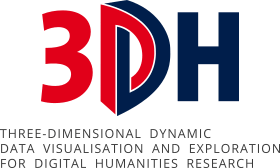Elaborate visual simulations for cultural heritage studies have a sustainability problem. As Erik Champion told us, they are often broken before the project even ends. For that matter, why do most museum interactive exhibits break before I get a chance to try them? If visualizations are to develop as a form of scholarly communication we need to imagine how to build visualizations that are sustainable.
Sustainability of digital scholarship has been addressed by organizations like Ithaka S+R in their Sustaining Our Digital Future: Institutional Strategies for Digital Content (PDF) and by scholars like Jerome McGann in Sustainability: The Elephant in the Room. The Ithaka report rightly points out all the human and technical infrastructure that supports projects that is overlooked and not considered by projects. Projects usually get funding to be created, but not maintenance funding and there are no strategies to develop units like libraries to sustain projects (as opposed to just preserving the data.) McGann points out how the third leg of scholarship, namely the scholarly publishers, is struggling and we need to imagine what a healthy scholarly publishing industry would look like in the digital age.
How can we imagine infrastructure for visualization that is sustainable, not only over the course of a project, but over the time that you share an insight?

